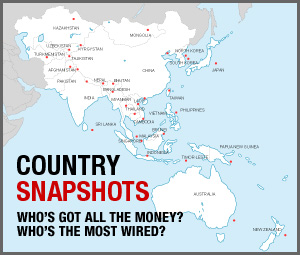
Economic Development
image: Chen WuThe first decade of the new millennium clearly established the Asia-Pacific region’s potential to emerge as the centre of gravity for the world economy, with the rise of China and India creating new growth poles accounting for more than half of global incremental output in purchasing power parity terms.
The global financial and economic crisis of 2007/08 did disrupt the growth momentum in the region, with growth rates slowing in most economies and some economies contracting in 2009. However, with governments responding promptly and vigorously with countercyclical measures, signs of recovery have emerged and a V-shaped recovery in 2010 seems within the realm of possibilities.
However, there are a number of policy challenges that need to be responded to for sustaining the dynamism of the region in the coming decades.
Firstly, it is clear that even with recovery, demand in Western countries, especially the United States, will remain weak as they adjust to global imbalances by curbing credit-fuelled consumption through realignment of exchange rates or protectionism. Therefore, the Asia-Pacific region will need to develop new sources of growth to make up for the lost demand. The new engines include a rebalancing of the economies towards greater domestic and regional consumption. With 860 million poor people, the Asia-Pacific region has substantial headroom for adding millions of new consumers to create additional aggregate demand. Hence, poverty reduction strategies for narrowing development gaps between and within sub-regions, strengthening social protection and paying attention to agriculture, small and medium enterprises and rural development, strengthening financial inclusion and other initiatives should be front and centre of development policy.
Regional economic cooperation could be another aspect of rebalancing. Recognizing its potential, the Asia-Pacific region is moving towards integration with numerous bilateral and sub-regional free trade arrangements linking countries in its own version of a noodle-bowl. A new grouping of East Asia Summit was formed in 2005 as a forum of 16 Asia-Pacific economies and is seeking to create a Comprehensive Economic Partnership of East Asia (CEPEA) bringing together economic powerhouses such as Japan, China and India along with the ASEAN economies. Creation of a larger unified market in the Asia-Pacific region, coupled with improved connectivity and trade and investment facilitation, will create new sources of growth.
Finally, there are substantial unexploited opportunities for monetary and financial cooperation in the region. A broader and comprehensive institutional architecture is needed for assisting Asia-Pacific not only in crisis prevention but also in intermediating between region’s excess savings and growing investment gaps, which should help to narrow development gaps while generating new aggregate demand. Such architecture could also assist in exchange rate cooperation and the management of capital flows that are bringing with them volatility in emerging economies and help develop an Asian perspective on reform of the international financial architecture.
Hopefully these challenges will be addressed in earnest by the region’s leadership to enable them to pave the way for making the 21st Century truly Asia’s Century!
Nagesh Kumar is Chief Economist of UN-ESCAP (United Nations Economic and Social Commission for Asia and Pacific), Bangkok. The views expressed herein are those of the author and do not necessarily reflect the views of the United Nations. Comments are welcome at [email protected]











